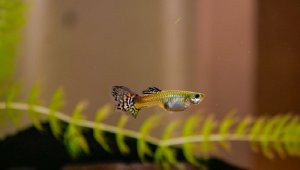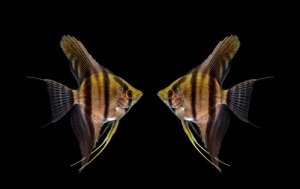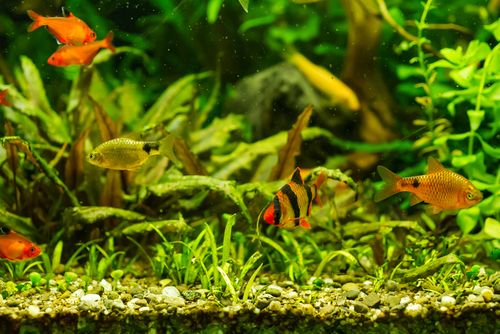
If you’ve ever wondered what fish suit a community aquarium, you will have found that Barb fish can be some of the most versatile tankmates. Did you know that there are over 40 different Barb Fish types, many of which come from Southeast Asia? If you’re looking for a guide to help choose between various Types of Barb Fish, this article will show you the differences between some of the most recommended varieties.
What Do Different Types Of Barb Fish Need To Thrive?
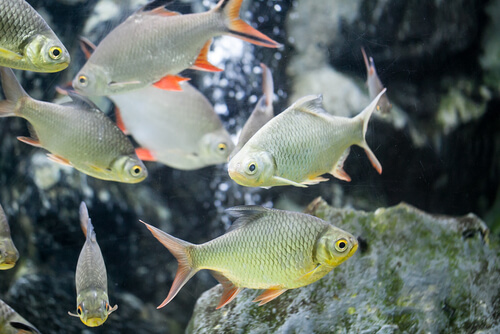
Barb fish tend to be subtropical or tropical, and many species have similar enough needs that they can be kept together in a community tank. A good rule of thumb is to use a strong filter and a tank of a minimum of 30 gallons for a shoal of a half dozen small Barbs (Rosy, Gold, Tiger) or 50 gallons/227 liters for larger Barbs like the Clown Barb.
Barbs are omnivores and like to eat a mix of protein and vegetables. Feed them on a tropical fish flake or pellet food and supplement them with blanched vegetables such as lettuce, as well as protein like bloodworms, brine shrimps, and daphnia.
Like any fish tank, you should change the water once per week, replacing about a third of it. Most tropical Barb Fish species enjoy a temperature of between 64-82 F. (18-27 C)
Author’s Note: A sandy substrate with lots of plants mimics the natural habitats of these fish in south and southeast Asia. Meanwhile, a slightly soft water condition and lower pH can be achieved with the addition of driftwood.
10 Most Recommended Barb Fish Types
1. Tiger Barb
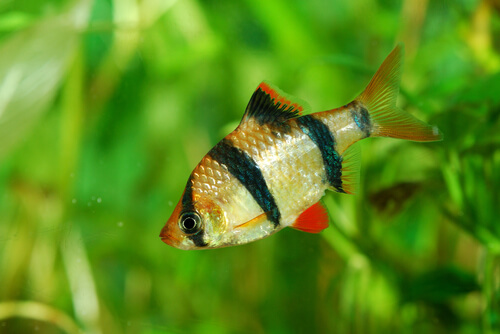
Tank Size (5-6 Fish): 30 gallons/114 liters
Tiger Barbs are one of the most popular and commonly seen types of Barbs in aquarium shops and are the happiest kept in groups of at least six. In fact, science has shown that group size directly affects welfare for Tiger Barbs. As they form shoals, they need a good amount of space to swim in without obstacles.
Best Tankmates:
Clown loaches and bottom-dwelling catfish make good tankmates for these Barbs. However, they don’t do well with fish that have trailing fins. This is because Tiger Barbs, like most Barbs, are fin-nipping species.
Things To Note:
Like most Barbs, they enjoy slightly soft water that is rich in vegetation. This is because this best mimics the natural streams these fish live in in the wild. Otherwise, Tiger Barbs are semi-aggressive and hierarchical, so if they don’t have enough space, they will compete with each other for food! To avoid this, you can add food to different parts of the tank so there aren’t so many fish feeding in the same space.
2. Rosy Barb
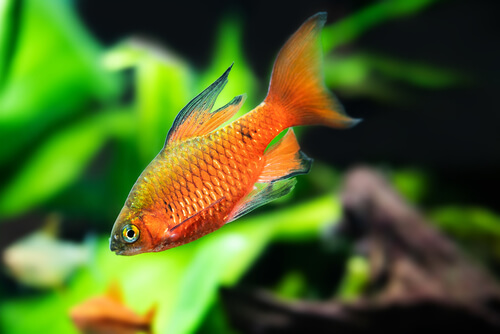
Tank Size (5-6 Fish): 30 gallons/114 liters
Rosy Barbs are attractive, bright red Barb Fish that come from southern Asia, including Cambodia and Myanmar. They have a similar temperament to other Barb species, meaning they love to be kept in groups, but can be semi-aggressive at feeding time.
Best Tankmates:
Like other Barbs, these guys can be kept with a variety of tankmates. Tiger Barbs and even the shyer Cherry Barb are good choices, so long as you have enough space. Like other Barbs, Rosy Barbs don’t go near the bottom of the tank that much. So, bottom-dwelling tankmates like oto catfish and kuhli loaches are also suitable.
Things To Note:
You can improve the coloring of these little fish by feeding them carotenoid-rich food such as brine shrimp. You may find, however, that your Barbs’ coloring is a good indicator of how stressed they are.
3. Gold Barb
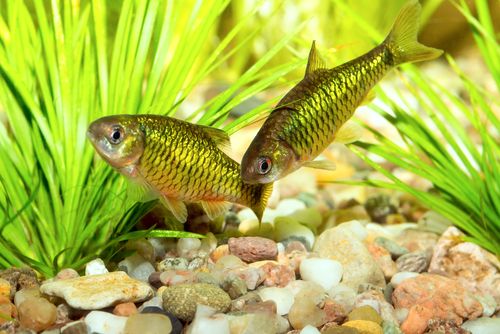
Tank Size (5-6 fish): 30 gallons/114 liters
The Gold Barb is a great fish if you want to draw the eye to your tank. It is a brightly colored, metallic Gold color and is also known as the Chinese Barb. It does originate from a wild variety, but this wild variety was green, not Gold. The Gold variety was first bred in captivity in the 1960s.
Best Tankmates:
The Gold Barb does well with other small Barbs as tank mates such as the Rosy Barb or Tiger Barb. It is a semi-aggressive fish but this shouldn’t be a problem if you keep it in a large enough tank and give it a group of about a half-dozen fish. As shoaling fish, Barbs feel safer in numbers and are therefore less likely to be aggressive.
Things To Note:
The Gold Barb needs much the same conditions as other Barb species. The best thing is to keep it in a tank with at least 5 gallons per tankmate and use a sandy substrate with plenty of plants.
Author’s Note: The Gold Barb should not be confused with the Gold Barb, which is a completely separate species that originates from Iran as opposed to China. However, luckily the fish you see in an aquatics store will generally be the Chinese Gold Barb.
4. Cherry Barb
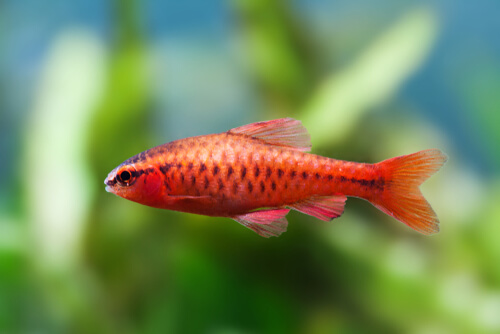
Tank Size (5-6 fish): 30 gallons/114 liters
Cherry Barbs are a great beginner species, but they’re also good if you want a fish that is less aggressive. These small fish from the Ghats region of India like sheltered tanks that have plenty of vegetation, and a sandy substrate. This best mimics their natural habitat where they enjoy hiding amongst different plants.
Best Tankmates:
Cherry Barbs don’t do well with other species of Barb due to the differences in aggression. They can be kept together in a large enough tank, instead, it’s just not ideal. Instead, you can keep them with placid species such as mollies and minnows or Danio species. These fish will keep themselves to themselves and your Cherry Barbs will feel safe and secure.
Things To Note:
Like all Barbs, they do well in groups of six or more. One thing that may attract you to this fish is its delightful sunset red color. As with the Rosy Barb, you may find that occasionally, the colors of your fish fade over time. However, you can help your fish maintain its color by feeding foods that are rich in carotenoids. Sometimes these are added to fish food. However, carotenoids are found naturally in many kinds of algae, and in brine shrimp.
Author’s Note: These guys love to hide! So, if you see your Cherry Barbs lurking around the base of plants or in nooks and crannies between rocks, don’t worry. These are shy fish that will come out into the open in their own time.
5. Snakeskin Barb
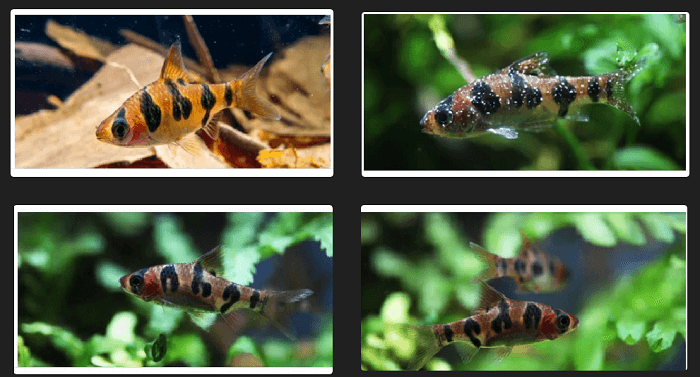
Tank Size (5-6 fish): 30 gallons/114 liters
This is one of the best Barb species that are less common. If you’re looking for something different than the popular Tiger Barb, a Snakeskin Barb is a good choice. It has similarly vivid coloration and gets on well with other tankmates.
Best Tankmates:
Any other small and peaceful fish are good with these guys. That includes Cherry Barbs, Gold Barbs, and Rosy Barbs. They can even work well with rasboras and gouramis providing there is enough space.
Things To Note:
You may also hear these Barbs called the ‘rhombo’ Barb. This comes from the rhombus-shaped markings on the sides of their bodies.
6. Tinfoil Barb
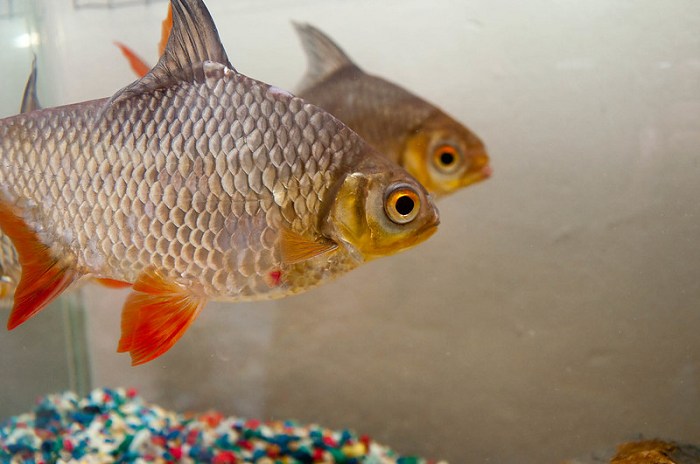
Tank Size (5-6 fish): 175 gallons/795 liters
If you were looking for a small Barb species, you will be surprised by the Tinfoil Barb! These fish come from southeast Asia, including Laos, China, and Cambodia, and can reach large sizes of over 15 inches/35 cm.
However, if you have the space for them, these are majestic fish with striking red fins and tails plus silver coloring that gives them their name.
Best Tankmates:
These fish do well with large tankmates like cichlids such as Oscars and even discus fish. This is because they are big enough to avoid bullying but also peaceful enough that they won’t attack your other fish.
Things To Note:
Remember how much bigger these Barbs can grow. Although they may look small when you get them, a tank that allows them to grow will ensure they are happier and healthier. However, despite their larger size, they actually have a mostly vegetarian diet in the wild, where almost half their food comes from phytoplankton.
7. African Banded Barb
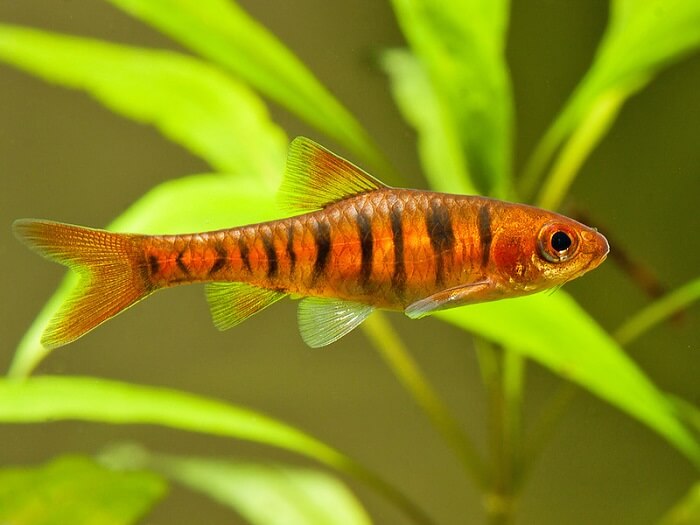
Tank Size (5-6 fish): 30 gallons/114 liters
The African Banded Barb is a small species that comes from river systems in Zambia, in southeastern Africa. It’s a striking little fish that makes a good tankmate for other peaceful fish.
Best Tankmates:
Good tankmates for the African Banded Barb include other small Barbs like the Rosy Barb and Gold Barb. Occasionally they can get on with bottom dwellers like cory catfish and kuhli loaches.
Things To Note:
Tank conditions are comparable to the Rosy Barb, Gold Barb, or Tiger Barb. Otherwise, these guys are on the smaller, shyer side, and prefer water at the warmer end of the Barb range.
8. Clown Barb
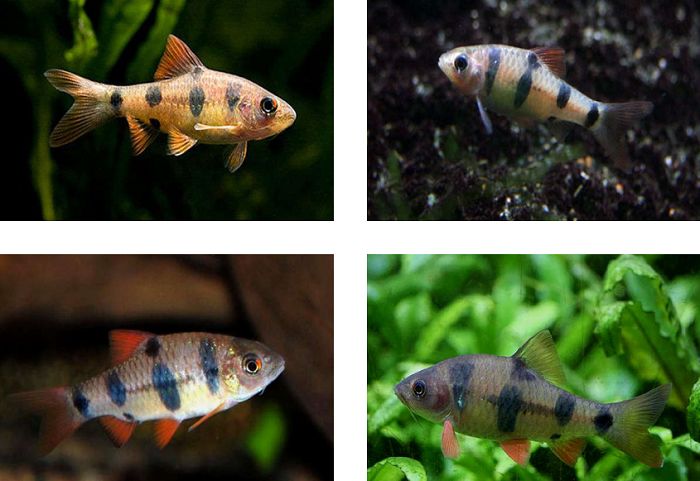
Tank Size (5-6 fish): 50 gallons/227 liters
The Clown Barb is a larger Barb that can grow up to 15 cm or 6-7 inches. As a result, like the Tinfoil Barb, you will need a larger tank with plenty of horizontal swimming area. These guys have distinctive coloring and their tones range from beige to brown to orange.
Best Tankmates:
These guys can get a bit larger, but generally, they are good tankmates for Tiger Barbs, Cherry Barbs, and Rosy Barbs.
Things To Note:
Like any Barb, they should have a large enough tank and a medium water flow. Even though they are on the bigger side, shoaling ability is still important for these fish. Fish that can safely form a shoal will be less stressed and therefore less aggressive.
9. Odessa Barb
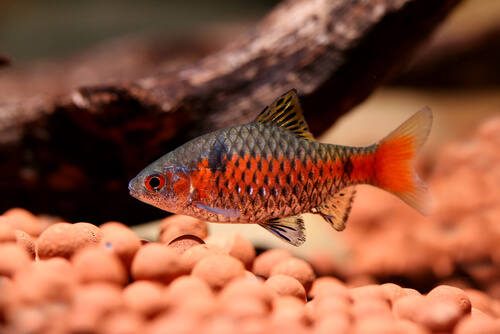
Tank Size (5-6 fish): 30 gallons/114 liters
The Odessa Barb is a very recent discovery in the aquarium trade. In fact, it was only popularised in the 1970s, in Ukraine, which is where it gets its name form. At first, it was thought that this Barb was a hybrid that developed in captivity. However, a wild population was found in Myanmar in the 21st century.
Best Tankmates:
These are small Barbs, growing up to 5 centimeters or 2.5 inches. Therefore, they do well with other small Barbs like the Rosy Barb, or other small tankmates like minnows and Danios.
Things To Note:
As a smaller species, it’s always important to give the Odessa Barb lot of places to hide in a community tank. This helps prevent territorial disputes both between species and within a shoal. Otherwise, Odessa Barb care is similar to other small Barb, although it can tolerate slightly cooler water.
Author’s Note: The Odessa Barb is one of the few Barb species that exhibit sexual dimorphism! This means the male and female are very easy to tell apart. In fact, the distinctive multicolored body of the male is one of the things that has made this fish so popular. The female has more muted colors but is still a stunning silver.
10. Denison’s Barb
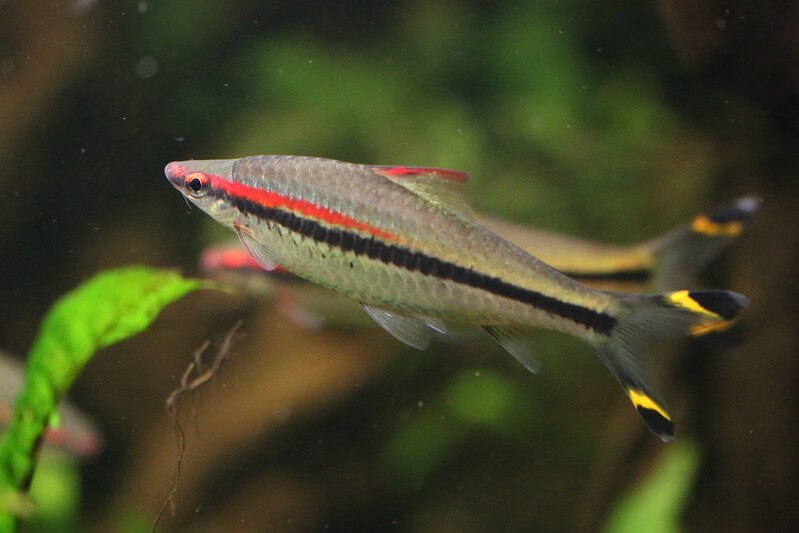
Tank Size (5-6 fish): 50 gallons/227 liters
The Denison’s Barb is a much larger Barb species than many others and can reach up to 15 cm or 6-7 inches.
You may also hear this fish called the ‘Roseline Shark’. However, this is actually not a shark at all. In fact, true sharks have cartilaginous skeletons, whereas the Roseline Shark has a bony skeleton like any other Barb. However, they earned their name with their large size and unique, streamlined shape.
Best Tankmates:
These Barbs can live with a variety of tankmates due to their large size and short fins. A good choice to keep them with is the Tiger Barb. Both these fish have striking colors and will form their own schools. They also require similar water conditions. Other good tankmates are the Cherry Barb, Rosy Barb, and cory catfish.
Things To Note:
As these Barbs are on the larger size, a 30-gallon/114 liter tank at minimum is recommended for a small group, ideally for a shoal of 5-6 a 40-gallon/181 liter tank is better.
What Barb Fish Species Are Best For Beginners?
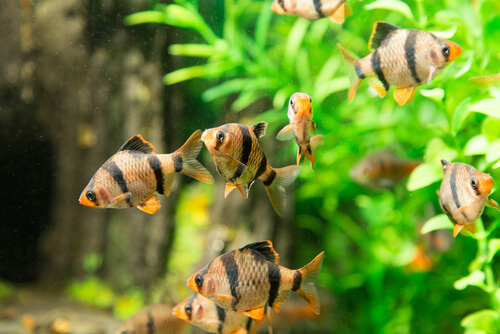
The best Barb Fish species for beginners are those that are both peaceful and hardy. They also don’t take up much space. This means the Tiger Barb and Rosy Barb are always great for a first-time fishkeeper. However, if you have kept tropical fish before, you may find some shyer Barbs like the Cherry Barb and Snakeskin Barb are also easy to take care of.
Final Thoughts
Barbs are an incredibly diverse group of fish with only a few things that unify them. Therefore, you may be unsure as to which ones to use as tankmates, or how best to build a community tank for your Barbs.
However, this guide covers some of the main species that can fill different needs for fishkeepers – from tankmates for larger cichlid species to a perfect beginner community tank.


